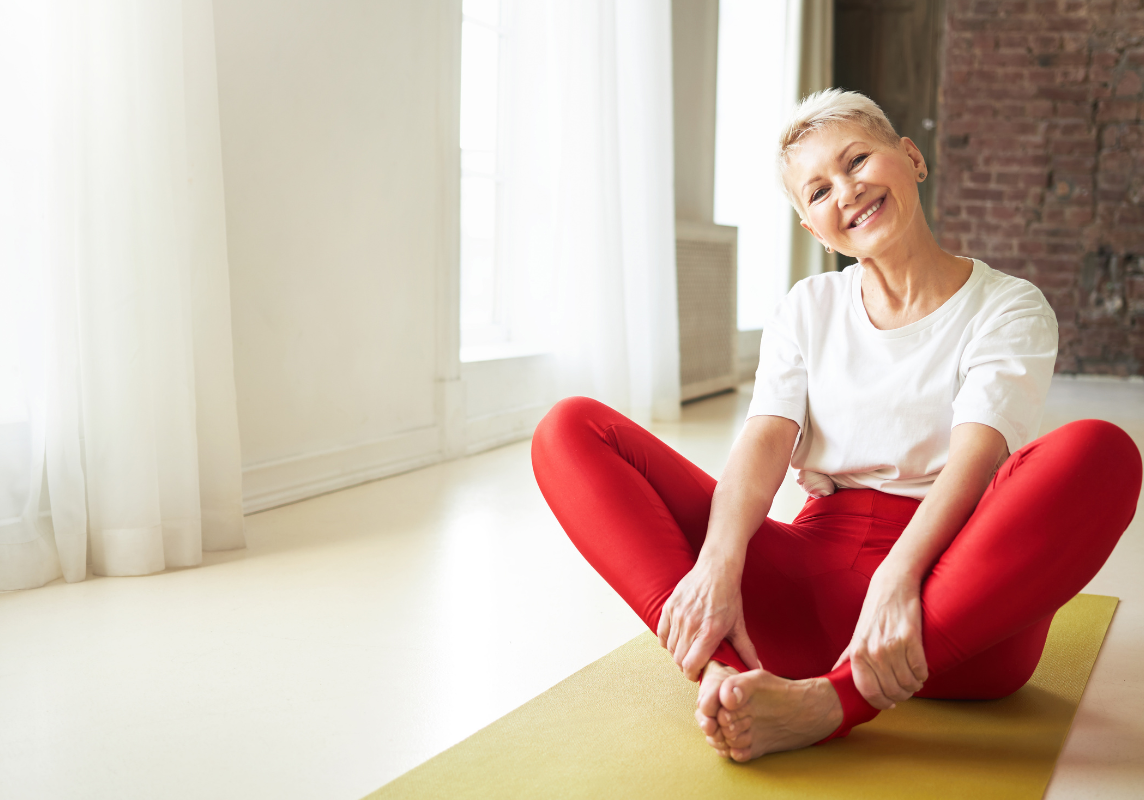
5 yoga practices for menopause anxiety & overwhelm
Using yoga to help with menopause anxiety. By Ceri Lee
I remember going to the GP in my early forties convinced of an impending heart attack. It was a difficult time in life and my heart had begun to hurt. I was scared. The GP wasn't worried, he diagnosed anxiety and handed over a prescription for betablockers.
In taking the prescription home, at that moment came the decision to focus more deeply on pranayama (yogic breathing practices) and meditation to help relieve my heart instead of taking the medication. I had been teaching yoga for over 10 years and knew what to do. After a week of daily practice, the heart stopped hurting and it felt possible to face life again.
Then, after a hysterectomy aged 49, the same symptoms returned overnight following surgery. This time I knew what to do and applied the same breathing techniques to relieve the pressure and pain in the chest.
Menopause signifies the end of a woman’s fertile years with diminishing sex hormones. Peri menopause is when the hormones begin to fluctuate and some of the main physical symptoms begin to show, including irregular periods, hot flushes, and night sweats.
Common non-physical symptoms include:
- Anger & irritability
- Mental fatigue
- Anxiety
- Low mood/depression
Menopause anxiety and overwhelm
Anxiety is a heightened state of nervousness in response from the nervous system affecting our heartbeat and how we breathe. A study of 3,000 women aged between 40-55 showed that 50% had symptoms of anxiety, tension, irritability, and irrational fear.
Fluctuations in the hormones oestrogen and progesterone, sleep disturbances during menopause can cause anxiety. Life changes like children leaving home, work commitments, and the impact of modern life on midlife women can also bring on anxiety due to stress.
Gen X women are the first generation dealing with the stress of modern living, including having a family as well as a full-time career, along with the temptation of fast food or a processed diet and excess alcohol.
How can yoga help manage anxiety?
When anxious, your body goes into fight-or-flight mode, a biological response that produces the stress hormones adrenaline and cortisol, causing shallow breathing and a faster heartbeat as well as other symptoms. It is a survival instinct developed by our ancient ancestors in response to threats such as wild animals. Our amygdala, the oldest part of the brain, responds to perceived danger and sends signals to the sympathetic nervous system.
When anxious, the brain sends the same message to the body to act accordingly in a perceived threatening situation. The strong feelings that anxiety evokes stop your thinking because the brain is focused on preparing the body to fight or run from the apparent danger.
Yoga asana (posture) and pranayama (yogic breathwork) give you head space and bring you back to a rational state. The following asana and breathing techniques activate the relaxation response and are powerful tools to relieve anxiety and stress in the mind.
5 yoga practices to relieve menopause anxiety and overwhelm
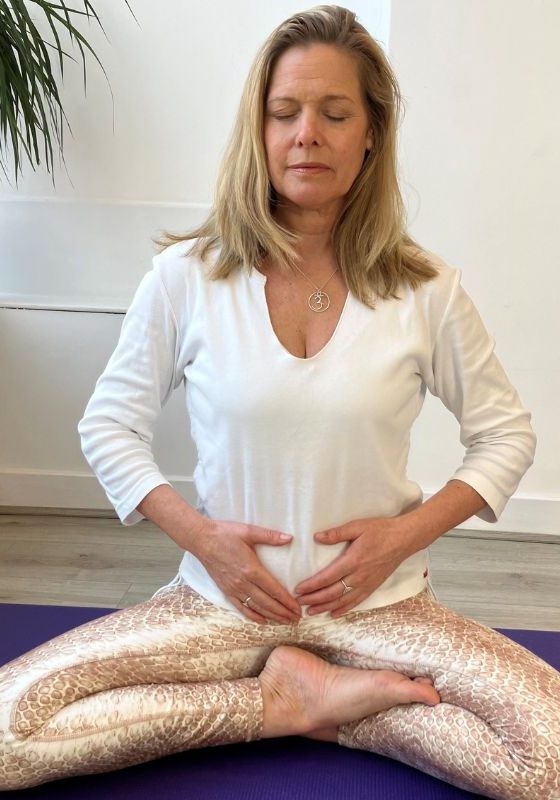
1. Abdominal breath
Dropping the breath down to the belly is grounding and encourages the relaxation response. The slow, even breath relaxes taut muscles whilst increasing bloody supply and nutrients to the muscles.
Here's how you do it:
- Sit in sukhasana (cross legged) or on a chair with your feet placed firmly on the ground, placing your hands on your thighs.
- Breathe in through the nose and breathe out with a soft sigh. Repeat four times.
- Now place your hands on your belly and breathe slowly in and out through the nose.
- Bring your attention to your belly and slowly draw the breath down, relaxing the abdomen so it expands.
- When you breathe out, encourage the abdomen to contract back into the body.
- Repeat for a minute or until you feel settled.
2. Alternate Nostril Breathing: Anuloma Viloma
This practice rebalances energy and provides optimum function to the brain by creating equilibrium between creativity and logic. Blood receives a larger amount of oxygen and soothes the entire nervous system, so the mind feels calm and relaxed. It increases vitality, clarity and lowers stress levels. The technique requires breathing in through one nostril, retaining the breath and exhaling through the alternate nostril.
- Practice in sukhasana, a cross-legged sitting posture with hands on your knees, or sit in a chair with feet on the floor and hands on the thighs.
- Gently bring the left thumb and forefinger together in jnana mudra, and tuck the right fore and middle finger into the palm of your right hand in vishnu mudra.
- Close your eyes and take several slow breaths.
- Close the right nostril with the right thumb and inhale through the left nostril for three counts.
- Close both nostrils and hold the breath for up to 12 counts. (Begin with three and increase counts when comfortable).
- Open the right nostril with the thumb and exhale through the right nostril for six counts.
- Inhale through the right nostril for three counts.
- Close both nostrils and hold the breath for up to 12 counts.
- Open the left nostril with the ring finger and exhale through the left nostril for six counts.
- Repeat five times.
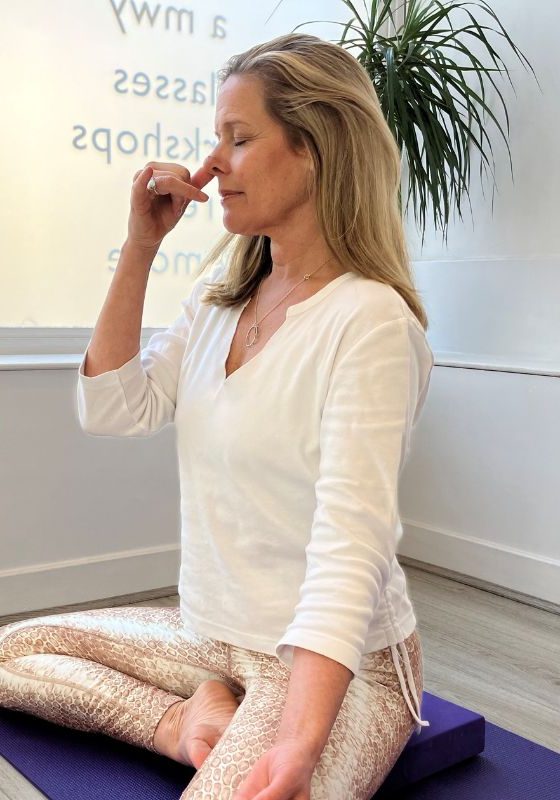
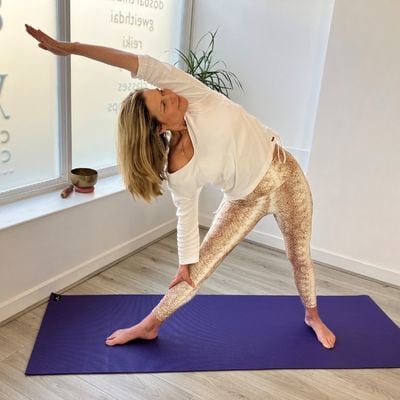
3. Triangle: Trikonasana (Sivananda Style)
This side-line posture strengthens the spinal nerves, activating the whole functioning of the nervous system to relieve anxiety and depression. Because of its unique rebalancing of the parasympathetic nervous system (de-stress triggers), it is beneficial to practice in the evening before bed. It tones and massages the pelvic organs, removes stiffness in the hips, legs, back and shoulders, aids digestion, tones the waistline, strengthens ankles and develops the chest.
- On your mat, step into five-pointed star, and adjust the right foot 90°.
- Inhale the left arm up to the sky and exhale over to the right, letting the right hand drop down to touch the right leg.
- Aim to bring the left arm parallel with the mat.
- Remain here for five slow breaths.
- Inhale up and repeat on other side.
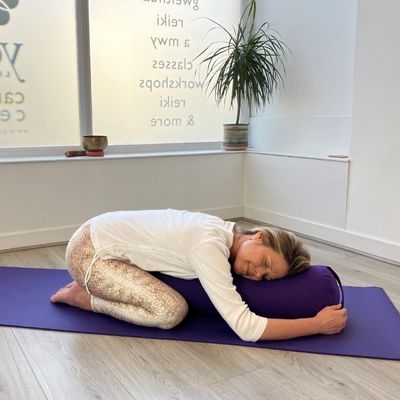
4. Supported Child: Salamba Balasana
Balasana opens the hips, relieves tension in the pelvis and lengthens the spine. It also encourages deeper breathing and gently increases blood supply to the head and neck. Supported child uses cushions, bolster and/or blankets for deeper release.
- Kneel down, and bring the top end of the bolster or rolled blanket between the knees.
- Sit back on heels (if this puts too much pressure on the knees, place a cushion or bolster between upper and lower legs).
- Rest chest and roll the head on one side on the bolster (or rolled blankets).
- Hug the bolster or blankets or bring arms alongside the body.
- Breathe slowly into the back body for several minutes.
- Come out of the asana gently and slowly.
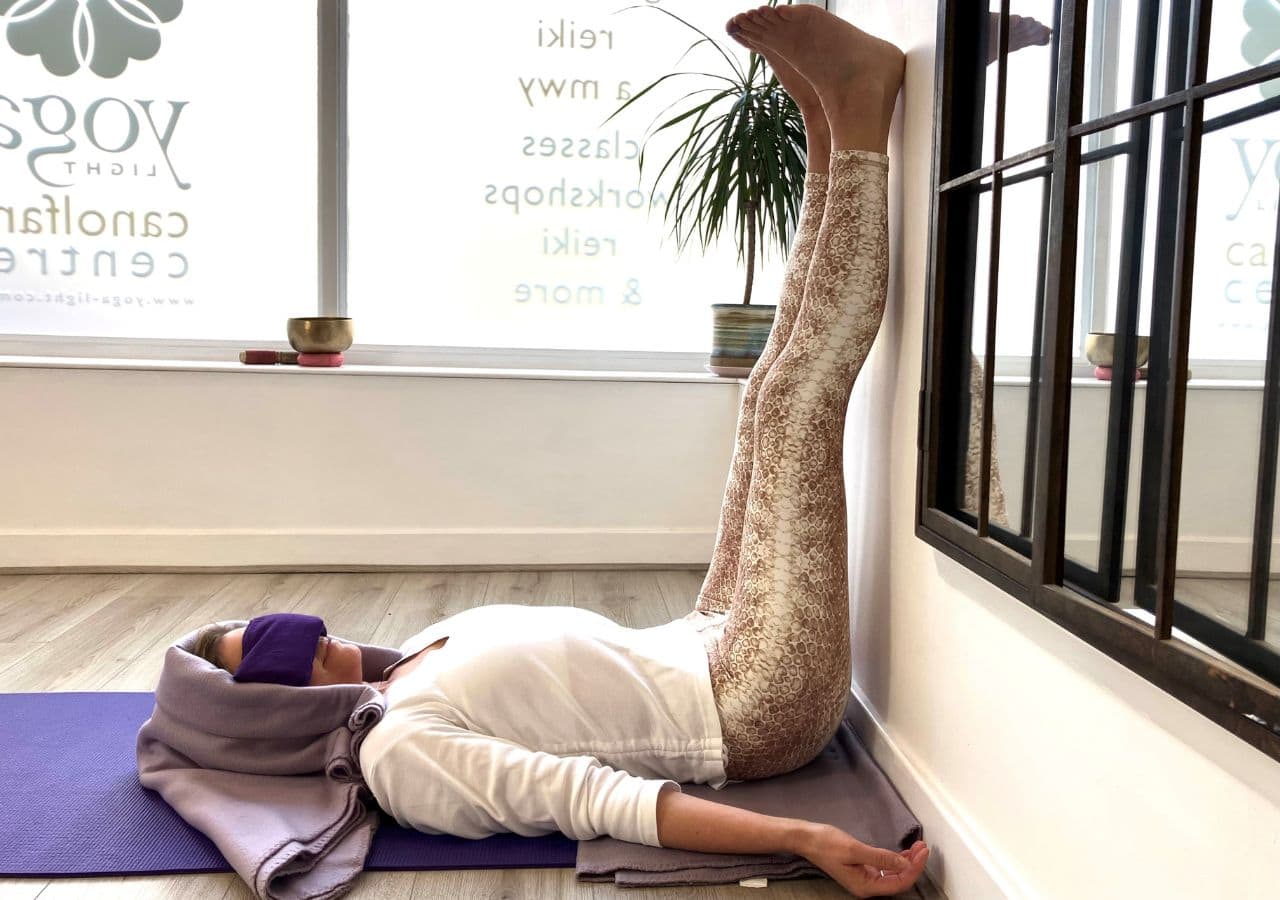
5. Legs Up the Wall: Viparita Karani
Not only is this asana effective in relieving anxiety by regulating blood flow, but it also relieves swollen ankles, improves digestion, restores tired feet and ankles, relieves headaches, and helps boost vitality and youthfulness.
- Bring mat to the wall, with a blanket, folded in half at the top end of the mat.
- Place your bottom close to the wall, placing a folded blanket or cushion if there's discomfort.
- Lay your head on the blanket at the top end of the mat.
- In foetal position with the feet on the wall, walk the feet up the wall so the legs begin to straighten upwards.
- Place an eye cushion over the eyes and draw the blanket around the head and shoulders.
- Take a few moments to rest here.
Other ways to relieve anxiety:
• Exercise
• Gut-friendly diet
• Reduce caffeine & alcohol
• Good sleep routine
• Massage, reiki, and acupuncture
• Join a support group
Ceri Lee is a yoga teacher of over 20 years and the founder of Yoga Light (yoga-light.com). Connect on Instagram @ceriyogalight




